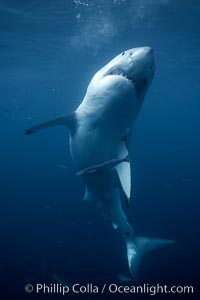
Great white shark, underwater.
Species: Great white shark, Carcharodon carcharias
Location: Guadalupe Island (Isla Guadalupe), Baja California, Mexico
Image ID: 21362
Species: Great white shark, Carcharodon carcharias
Location: Guadalupe Island (Isla Guadalupe), Baja California, Mexico
Image ID: 21362
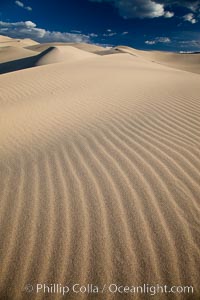
Eureka Dunes. The Eureka Valley Sand Dunes are California's tallest sand dunes, and one of the tallest in the United States. Rising 680' above the floor of the Eureka Valley, the Eureka sand dunes are home to several endangered species, as well as "singing sand" that makes strange sounds when it shifts. Located in the remote northern portion of Death Valley National Park, the Eureka Dunes see very few visitors.
Location: Eureka Dunes, Death Valley National Park, California
Image ID: 25250
Location: Eureka Dunes, Death Valley National Park, California
Image ID: 25250
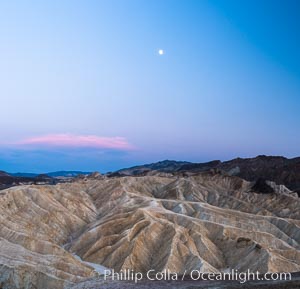
Full moon over Zabriskie Point landscape.
Location: Zabriskie Point, Death Valley National Park, California
Image ID: 28676
Location: Zabriskie Point, Death Valley National Park, California
Image ID: 28676
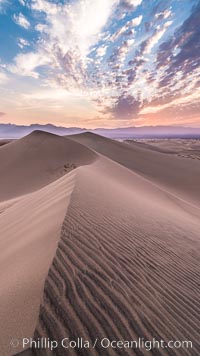
Mesquite Dunes sunrise, dawn, clouds and morning sky, sand dunes.
Location: Stovepipe Wells, Death Valley National Park, California
Image ID: 28688
Location: Stovepipe Wells, Death Valley National Park, California
Image ID: 28688
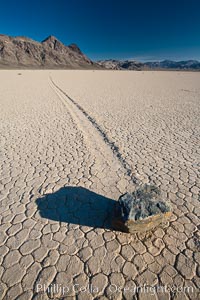
A sliding rock of the Racetrack Playa. The sliding rocks, or sailing stones, move across the mud flats of the Racetrack Playa, leaving trails behind in the mud. The explanation for their movement is not known with certainty, but many believe wind pushes the rocks over wet and perhaps icy mud in winter.
Location: Racetrack Playa, Death Valley National Park, California
Image ID: 25239
Location: Racetrack Playa, Death Valley National Park, California
Image ID: 25239
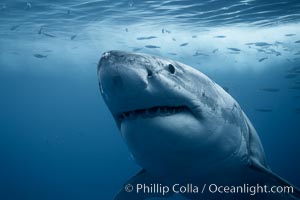
Great white shark, underwater.
Species: Great white shark, Carcharodon carcharias
Location: Guadalupe Island (Isla Guadalupe), Baja California, Mexico
Image ID: 21360
Species: Great white shark, Carcharodon carcharias
Location: Guadalupe Island (Isla Guadalupe), Baja California, Mexico
Image ID: 21360
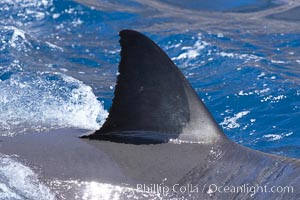
Dorsal fin of a great white shark breaks the surface as the shark swims just below.
Species: Great white shark, Carcharodon carcharias
Location: Guadalupe Island (Isla Guadalupe), Baja California, Mexico
Image ID: 19490
Species: Great white shark, Carcharodon carcharias
Location: Guadalupe Island (Isla Guadalupe), Baja California, Mexico
Image ID: 19490
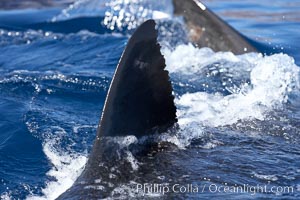
Great white shark, dorsal fin extended out of the water as it swims near the surface.
Species: Great white shark, Carcharodon carcharias
Location: Guadalupe Island (Isla Guadalupe), Baja California, Mexico
Image ID: 21353
Species: Great white shark, Carcharodon carcharias
Location: Guadalupe Island (Isla Guadalupe), Baja California, Mexico
Image ID: 21353
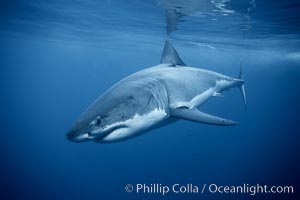
Great white shark, underwater.
Species: Great white shark, Carcharodon carcharias
Location: Guadalupe Island (Isla Guadalupe), Baja California, Mexico
Image ID: 21358
Species: Great white shark, Carcharodon carcharias
Location: Guadalupe Island (Isla Guadalupe), Baja California, Mexico
Image ID: 21358
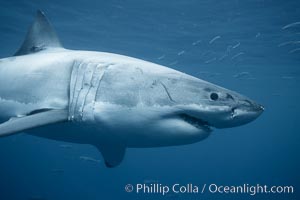
Great white shark, underwater.
Species: Great white shark, Carcharodon carcharias
Location: Guadalupe Island (Isla Guadalupe), Baja California, Mexico
Image ID: 21359
Species: Great white shark, Carcharodon carcharias
Location: Guadalupe Island (Isla Guadalupe), Baja California, Mexico
Image ID: 21359
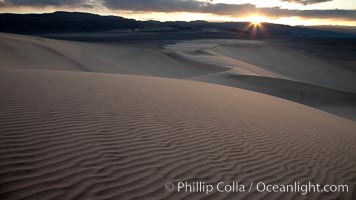
Sunset on the Eureka Dunes. The Eureka Valley Sand Dunes are California's tallest sand dunes, and one of the tallest in the United States. Rising 680' above the floor of the Eureka Valley, the Eureka sand dunes are home to several endangered species, as well as "singing sand" that makes strange sounds when it shifts. Located in the remote northern portion of Death Valley National Park, the Eureka Dunes see very few visitors.
Location: Eureka Dunes, Death Valley National Park, California
Image ID: 25240
Location: Eureka Dunes, Death Valley National Park, California
Image ID: 25240
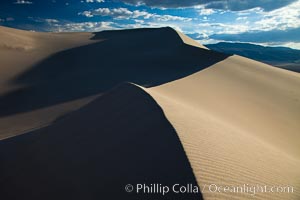
Eureka Dunes. The Eureka Valley Sand Dunes are California's tallest sand dunes, and one of the tallest in the United States. Rising 680' above the floor of the Eureka Valley, the Eureka sand dunes are home to several endangered species, as well as "singing sand" that makes strange sounds when it shifts. Located in the remote northern portion of Death Valley National Park, the Eureka Dunes see very few visitors.
Location: Eureka Dunes, Death Valley National Park, California
Image ID: 25241
Location: Eureka Dunes, Death Valley National Park, California
Image ID: 25241
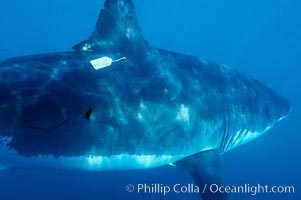
A great white shark bearing a white plastic researcher's identification ID tag near its dorsal fin swims through the clear waters of Isla Guadalupe, far offshore of the Pacific Coast of Baja California. Guadalupe Island is host to a concentration of large great white sharks, which visit the island to feed on pinnipeds and tuna.
Species: Great white shark, Carcharodon carcharias
Location: Guadalupe Island (Isla Guadalupe), Baja California, Mexico
Image ID: 07739
Species: Great white shark, Carcharodon carcharias
Location: Guadalupe Island (Isla Guadalupe), Baja California, Mexico
Image ID: 07739
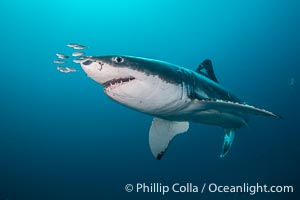
Great White Shark, South Neptune Islands, South Australia.
Species: Great white shark, Carcharodon carcharias
Location: South Neptune Islands, South Australia
Image ID: 39144
Species: Great white shark, Carcharodon carcharias
Location: South Neptune Islands, South Australia
Image ID: 39144
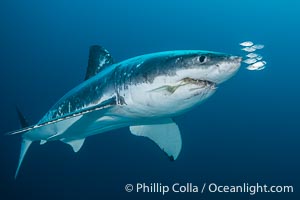
Great White Shark, South Neptune Islands, South Australia.
Species: Great white shark, Carcharodon carcharias
Location: South Neptune Islands, South Australia
Image ID: 39145
Species: Great white shark, Carcharodon carcharias
Location: South Neptune Islands, South Australia
Image ID: 39145
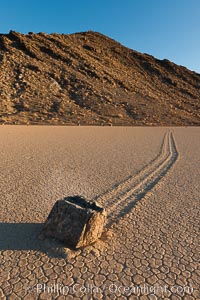
Sailing stone on the Racetrack Playa. The sliding rocks, or sailing stones, move across the mud flats of the Racetrack Playa, leaving trails behind in the mud. The explanation for their movement is not known with certainty, but many believe wind pushes the rocks over wet and perhaps icy mud in winter.
Location: Racetrack Playa, Death Valley National Park, California
Image ID: 27691
Location: Racetrack Playa, Death Valley National Park, California
Image ID: 27691
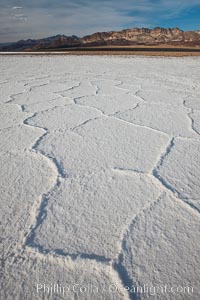
Salt polygons. After winter flooding, the salt on the Badwater Basin playa dries into geometric polygonal shapes.
Location: Badwater, Death Valley National Park, California
Image ID: 25242
Location: Badwater, Death Valley National Park, California
Image ID: 25242
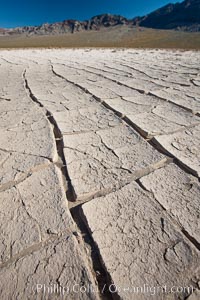
Dried mud, arid land, Eureka Valley.
Location: Eureka Valley, Death Valley National Park, California
Image ID: 25244
Location: Eureka Valley, Death Valley National Park, California
Image ID: 25244
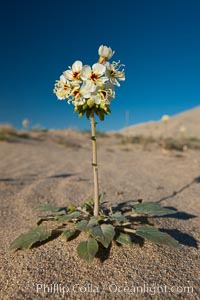
Spring wildflower blooms on the Eureka sand dunes.
Location: Eureka Dunes, Death Valley National Park, California
Image ID: 25245
Location: Eureka Dunes, Death Valley National Park, California
Image ID: 25245
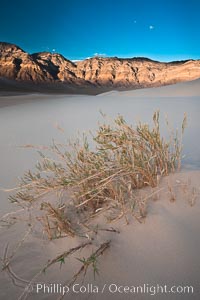
Eureka dune grass is a rare and federally endangered species of grass endemic to the Eureka Valley and Eureka Sand Dunes. The Last Chance mountains, lit by sunset, are visible in the distance. Swallenia alexandrae, a perennial grass, grows only in the southern portion of Eureka Valley Sand Dunes, in Inyo County, California.
Species: Eureka dune grass, Swallenia alexandrae
Location: Eureka Dunes, Death Valley National Park, California
Image ID: 25358
Species: Eureka dune grass, Swallenia alexandrae
Location: Eureka Dunes, Death Valley National Park, California
Image ID: 25358
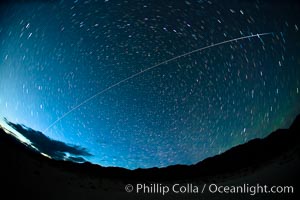
International Space Station flys over Death Valley shortly after sunset.
Location: Earth Orbit, Solar System, Milky Way Galaxy, The Universe
Image ID: 25247
Location: Earth Orbit, Solar System, Milky Way Galaxy, The Universe
Image ID: 25247
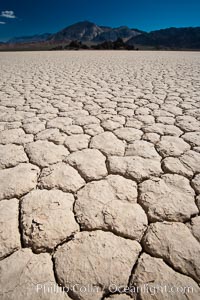
Racetrack Playa, an ancient lake now dried and covered with dessicated mud.
Location: Racetrack Playa, Death Valley National Park, California
Image ID: 25264
Location: Racetrack Playa, Death Valley National Park, California
Image ID: 25264
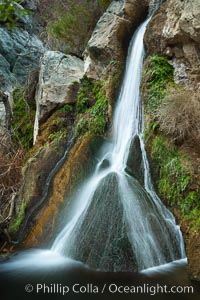
Darwin Falls in Death Valley, near the settlement of Panamint Springs. The falls are fed by a perennial stream that flows through a narrow canyon of plutonic rock, and drop of total of 80' (24m) in two sections.
Location: Death Valley National Park, California
Image ID: 27683
Location: Death Valley National Park, California
Image ID: 27683
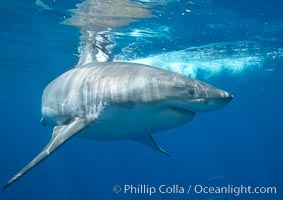
A great white shark is countershaded, with a dark gray dorsal color and light gray to white underside, making it more difficult for the shark's prey to see it as approaches from above or below in the water column. The particular undulations of the countershading line along its side, where gray meets white, is unique to each shark and helps researchers to identify individual sharks in capture-recapture studies. Guadalupe Island is host to a relatively large population of great white sharks who, through a history of video and photographs showing their countershading lines, are the subject of an ongoing study of shark behaviour, migration and population size.
Species: Great white shark, Carcharodon carcharias
Location: Guadalupe Island (Isla Guadalupe), Baja California, Mexico
Image ID: 19468
Species: Great white shark, Carcharodon carcharias
Location: Guadalupe Island (Isla Guadalupe), Baja California, Mexico
Image ID: 19468
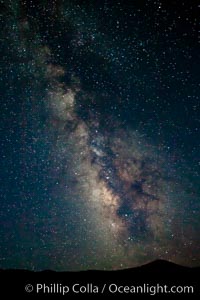
The Galactic Center of the Milky Way galaxy rises in the sky on a clear night.
Location: Milky Way Galaxy, The Universe
Image ID: 25246
Location: Milky Way Galaxy, The Universe
Image ID: 25246
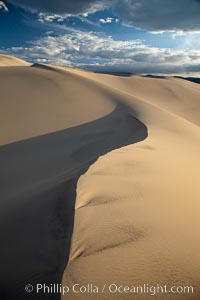
Eureka Dunes. The Eureka Valley Sand Dunes are California's tallest sand dunes, and one of the tallest in the United States. Rising 680' above the floor of the Eureka Valley, the Eureka sand dunes are home to several endangered species, as well as "singing sand" that makes strange sounds when it shifts. Located in the remote northern portion of Death Valley National Park, the Eureka Dunes see very few visitors.
Location: Eureka Dunes, Death Valley National Park, California
Image ID: 25249
Location: Eureka Dunes, Death Valley National Park, California
Image ID: 25249
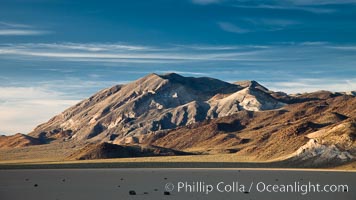
Sunset over the Racetrack Playa. The Cottonwood Mountains rise above the flat, dry, ancient lake bed.
Location: Racetrack Playa, Death Valley National Park, California
Image ID: 25265
Location: Racetrack Playa, Death Valley National Park, California
Image ID: 25265
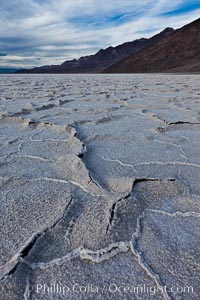
Salt polygons. After winter flooding, the salt on the Badwater Basin playa dries into geometric polygonal shapes.
Location: Badwater, Death Valley National Park, California
Image ID: 27631
Location: Badwater, Death Valley National Park, California
Image ID: 27631
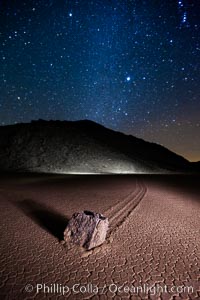
Racetrack sailing stone and Milky Way, at night. A sliding rock of the Racetrack Playa. The sliding rocks, or sailing stones, move across the mud flats of the Racetrack Playa, leaving trails behind in the mud. The explanation for their movement is not known with certainty, but many believe wind pushes the rocks over wet and perhaps icy mud in winter.
Location: Racetrack Playa, Death Valley National Park, California
Image ID: 27640
Location: Racetrack Playa, Death Valley National Park, California
Image ID: 27640
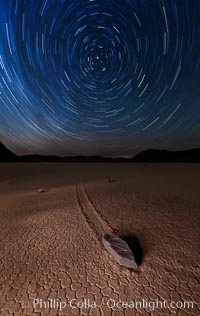
Racetrack sailing stone and star trails. A sliding rock of the Racetrack Playa. The sliding rocks, or sailing stones, move across the mud flats of the Racetrack Playa, leaving trails behind in the mud. The explanation for their movement is not known with certainty, but many believe wind pushes the rocks over wet and perhaps icy mud in winter.
Location: Racetrack Playa, Death Valley National Park, California
Image ID: 27667
Location: Racetrack Playa, Death Valley National Park, California
Image ID: 27667